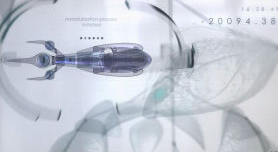New video game combines learning, fun

Eve Wurtele, professor of genetics, development and cell biology, and her team have created a video game called Meta!Blast, which is aimed to help students better understand certain biological concepts. Meta!Blast is available for Windows and Mac.
April 30, 2014
A new, ISU-developed game puts players in charge of a search-and-rescue team that’s been tasked to find a group of doctors who’ve gone missing while trying to save the last remaining plant cell. Their task involves finding the lost doctors, discovering what is killing the plant cells and saving the world.
Picture doing that at a microscopic size, while treading the surface of a leaf, rescuing a tardigrade and dodging nematodes.
Eve Wurtel, professor of genetics, development and cell biology, and her team have created the video game called Meta!Blast, which is aimed to help students better understand certain biological concepts.
“[Meta!Blast] is a computer game that is designed to engage students in biology and to get students involved in biology concepts. It’s very interactive, and it’s really fun. The object of the game is to rescue the doctor, but students learn along the way,” Wurtele, who is also the director of the game, said.
Wurtele said that the video game has been in the development stage for over four years now, and they are continuing to develop it. They have already completed three modules.
Wurtele said she hopes students learn a lot from the game, while also finding it fun to play.
“I want the students to get engaged in biology. I want them to see relationships in size scales as well,” she said. “There is a lot of physics and biology involved in the game, and I want them to understand that.”
Jeff Derocher, freshman in mechanical engineering, said he really enjoyed playing the game.
“I thought it was a cool and fun way to learn more,” Derocher said. “Sitting and listening to lectures and videos can get a little old, and the interactive game was a really cool change of pace.”
Every person who had a hand in developing the video game is or at one time was a student or faculty member at Iowa State, Wurtele said. Developers of Meta!Blast come from all different disciplines, including biology, art, computer science, music and design.
Diane Bassham, Maria Salas-Fernandez, Will Schneller, Anita Shah, Paul Klippel, Andrew Navratil, Greg Hanes, Paul Lin, Mandela Magnidjem and many more people were involved in development.
“This summer we will have undergraduates from Iowa State and other universities. Local teachers and faculty are involved as well,” Wurtele said. “There are a lot of people who are working on the game just for fun and care about educating students in different ways.”
Derocher shared how impressive he thought it was to have an all-ISU group.
“I think it’s really cool that everyone involved in creating the game has ties to Iowa State. It goes to show that there’s some awesome stuff going on here,“ he said.
Derocher said the idea of the video game reminded him of another educational program.
“When I first heard of the game, I was excited to try it out because it reminded me of the ‘Magic School Bus,’” he said.
Wurtele said she thought of the idea for the video game when she was teaching a core biology class.
“Some of the concepts [in biology] are really hard to grasp without 3-D information. I realized that you can’t do a lot of it with just speech and videos. I thought a video game would be really helpful and fun,” Wurtele said.
Wurtele said she incorporates Meta!Blast into all of her core biology classes, consisting of about 600 students. She said the game was not designed to replace lectures and books but to complement them.
Wurtele and her team recently earned the People’s Choice Award in the 2013 International Science and Engineering Visualization Challenge. The game was also featured in Science magazine.
“We were really excited [to win the award],” Wurtele said. “It showed that we created a really fine product. It was really nice to be recognized.”
Wurtele said that the National Institute of Health’s Science Education Partnership has been a big help in funding the program.
In a time when students are better versed in technology than ever, Wurtele and her team have opened a door to a new way of learning that could be beneficial to many students.
















